G1902
Gray Leaf Spot of Corn
All corn hybrids and inbreds are susceptible to gray leaf spot in varying degrees. This NebGuide discusses the symptoms, impacts and management of this disease.
Jennifer M. Rees, Extension Educator
Tamra A. Jackson, Extension Plant Pathologist
- Introduction
- Yield Impacts
- Disease Symptoms
- Infection Cycle
- Residue Management
- Hybrid Tolerance
- Acknowledgment
- Web Sites
Glossary |
|
| Chlorotic: | Yellowing of green leaf tissue which reduces photosynthetic activity. |
| Inoculum: | Amount of fungal spores capable of infecting a host the next season. |
| Lesion: | Area of the plant which is diseased. |
| Stomata: | Pores placed at the plant surface that allow gas exchange with the atmosphere. |
| Stromata: | Fungal over-wintering structures of C. zeae-maydis found in diseased leaf tissue which produce conidia the following growing season. |
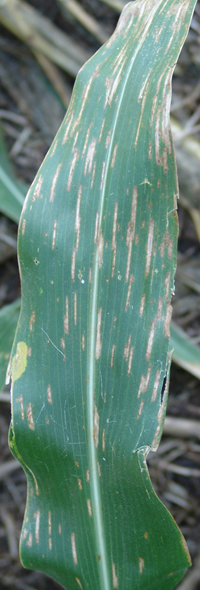 |
| Figure 1. Gray leaf spot (GLS). |
Introduction
Gray leaf spot (GLS) (Figure 1) caused by Cercospora zeae-maydis is considered the world’s most yield-limiting disease on corn. All corn hybrids, regardless of type, have some susceptibility to this disease.
First reported in the U.S. in Illinois in 1924, it has been a problem in Mid-Atlantic States and the eastern region of the Corn Belt for decades. GLS was first discovered in Nebraska near Henderson in 1990, but no yield loss was noted. Since 1994, yield losses of 5 percent to 50 percent have occurred over a wide area of the state. In the 1990s, unique weather patterns such as cooler temperatures and prolonged periods of overcast days, coupled with increased acreage of reduced tillage systems, may have favored GLS epidemics. More recently, an increase in the production of continuous corn, in response to greater demand, may further increase GLS pressure.
Yield Impacts
Factors such as hybrid susceptibility and favorable weather for pathogen infection and spread will highly influence how much impact gray leaf spot will have on corn production. Yield loss is primarily incurred when the top eight to nine leaves above the ear become diseased. These leaves contribute at least 75 percent of the carbohydrate content of the ear.
Because gray leaf spot reduces an ear’s photosynthetic area, the number of kernels per ear also are reduced, resulting in yield loss. In addition, the reduction in photosynthetic leaf area results in the transfer of carbohydrates from stalks to the developing ear, indirectly predisposing the plant to stalk rot and lodging caused by other pathogens.
In Nebraska, stalk rot pathogens usually include Fusarium, Stenocarpella (formerly known as Diplodia), and Colletotrichum (anthracnose). Extremely early season disease pressure can result in premature plant death, but this is rare in Nebraska.
| Table I. Predicted yield loss due to Gray Leaf Spot. (Source: Pat Lipps, The Ohio State University) | |
Percentage ear leaf
area affected
by early dent stage |
Approximate yield loss expected |
5% or less 6%-25 % 25%-75% 75%-dead leaf |
0-2% loss 2-10% loss 5-20% loss 15-50% loss |
Disease Symptoms
Early Symptom Recognition
Early GLS symptoms include brown or tan spots 0.2 inches wide by 0.4-0.8 inches long, which span the region between the leaf veins. These lesions become irregularly-shaped to rectangular-shaped with yellow margins (more visible upon backlighting).
Early gray leaf spot lesions (Figure 2) can be confused with other fungal diseases of corn such as anthracnose caused by Colletotrichum graminicola, eyespot caused by Kabatiella zeae, and early common rust pustules caused by Puccinia sorghi (Figure 3).
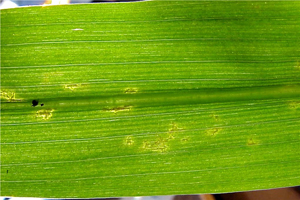 |
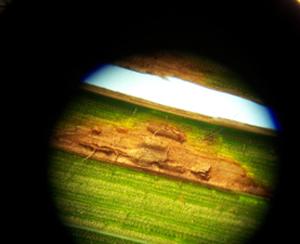 |
|
| Figure 2. Early gray leaf spot lesions. These lesions can be easily confused with those of other fungal diseases. | Figure 3. Magnified common rust lesion which looks like a gray leaf spot lesion in shape and color. Under magnification, the rust pustules are visible. Breaking them open results in spores. |
However, mature lesions are quite distinct being tan or gray, vein-limited, rectangular-shaped (0.2 inches wide and up to 2.8 inches long), with blunt-ends (Figure 4). The release of gray fungal spores in mature lesions gives the disease its name. Lesions run parallel to the leaf surface and, with increased severity, may coalesce, leading to blighting of entire leaves (Figure 5).
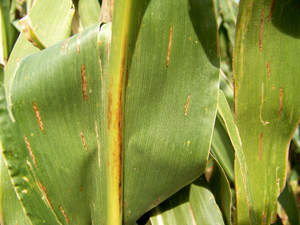 |
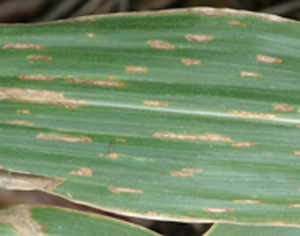 |
|||
| Figure 4. Mature gray leaf spot lesions are brown, rectangular-shaped, and vein-limited. | ||||
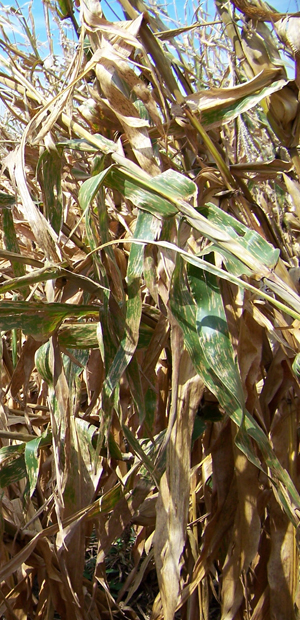 |
|
|||
| Figure 5. Blighting of leaves and entire plants due to severe gray leaf spot pressure. | ||||
Symptoms typically occur two to four weeks prior to pollination under favorable environmental conditions. Stalk infections have been reported and can result in lodging, if severe. Lesions on sheath or husk tissues may be oval in shape and are not usually diagnostic. On a field scale, plants in severely affected areas appear to undergo early senescence (dry-down).
Survival
C. zeae-maydis survives Nebraska winters as stromata in corn residue (Figure 6). The pathogen doesn’t compete well in the soil environment and rarely survives if residue is buried below the soil. However, if debris is located anywhere on or above the soil surface by April, it can be a potential inoculum source.
Infection Cycle
The infection cycle (infection, penetration and production of conidia) varies, depending upon hybrid genetics. On a susceptible hybrid, the infection cycle may require 14-21 days, or 21-28 days on a more tolerant hybrid. Potential benefits of lengthened infection cycles include fewer cycles per season and/or a delay in reaching the economic threshold for that hybrid. Under optimal environmental conditions in the greenhouse, the infection cycle was reduced to as little as seven to ten days.
Infections can occur in two ways: 1) from wind-blown spores from neighboring fields; or 2) from previous years’ corn residue infested with C. zeae-maydis. Seed transmission of the pathogen is not believed to be important to disease development.
Stromata surviving the winter in corn debris give rise to conidia (asexual fungal spores) in the spring and summer during periods of moist, humid conditions. These conidia are wind-blown or rain-splashed onto the lower leaves of the new crop. Conidia germinate and penetrate the leaves through stomata and other natural plant openings in four to seven days.
Chlorotic symptoms can develop in about nine days after infection, progressing into “typical” GLS lesions or necrotic, dead tissue. Fungal stromata produced within necrotic lesions can repeatedly produce secondary conidia 14 to 21 days after inoculation.
A typical gray leaf spot lesion can produce up to 5,000 conidia per square millimeter of leaf tissue. Consequently, the more leaf area affected and the larger the lesions, the greater the number of conidia produced. Fifty percent to 80 percent of the conidia produced are capable of germination. Diseased leaves and stalk debris that stay on the ground after harvest, where the stromata survive the winter, complete the cycle.
Weather
Infection cycles are regulated by prevailing weather conditions, primarily temperature and humidity. For example, conidia may stay on the leaf surface for several days before germinating and/or infection cycles may be lengthened if environmental conditions aren’t favorable. Also, changes in weather can slow or stop an epidemic.
Because it is endemic, GLS will appear annually in Nebraska, but its timing depends on environmental conditions. To infect, the pathogen requires at least 12 hours of free moisture and relative humidity greater than or equal to 90 percent with moderate temperatures (70-90°F/25-32°C). Leaf wetness can result from dew, rain, or irrigation. Relative humidity in Nebraska averages about 70 percent throughout the state with higher relative humidity within the corn canopy.
Management
Implementing several strategies will help producers mitigate disease effects, although some strategies, while beneficial, may not fit into a producer’s cropping system. The best management strategy for gray leaf spot either delays the epidemic’s onset and/or slows the rate of disease development.
Assessing Risk
The best management plan depends on the level of risk in the field. According to Paul Vincelli at University of Kentucky Extension, there are at least eight factors that contribute to higher risk potential for development of gray leaf spot. Management practices depend on which and how many risk factors apply.
High risk factors for gray leaf spot in corn:
- Susceptible hybrid
- Continuous corn
- Late planting date
- Minimum tillage systems
- Field history of severe disease
- Early disease activity (before tasseling)
- Irrigation
- Favorable weather forecast for disease
At present, gray leaf spot management has three major components: residue management, hybrid tolerance, and fungicide applications.
Residue Management
C. zeae-maydis cannot successfully survive in debris buried under soil. Generally, if residue covers 30 percent or more of a field that had gray leaf spot the previous season, damaging levels of the disease are likely with favorable weather conditions. However, as little as 10 percent residue coverage can lead to significant yield loss, depending on the hybrid’s tolerance to gray leaf spot and the disease pressure that year.
Although crop rotations can help minimize C. zeae-maydis inoculum levels, infected leaf and stalk/husk debris can still remain after one or two years respectively, particularly in minimum tillage systems. In Iowa, the number of fields in reduced tillage (greater than 15 percent surface residue) increased from 55.1 percent to 77.9 percent from 1983 to 1997. At the same time, gray leaf spot severity increased from 10 percent to 95 percent. Thus, where minimum tillage is implemented, hybrid tolerance and fungicide use, when necessary, may better combat this pathogen.
Hybrid Tolerance
Because it takes several genes to confer resistance to gray leaf spot, there are no truly resistant or immune hybrids available. However, selecting more tolerant hybrids is a good disease management tool. Hybrids vary widely in susceptibility to the gray leaf spot pathogen. More tolerant hybrids develop chlorotic and/or fleck type lesions upon infection whereas susceptible hybrids typically produce elongated necrotic lesions. Hybrids with high levels of tolerance to the disease have performed well in Nebraska over the last few years, even where disease levels are high. Currently, more than 50 percent of the companies selling seed in Nebraska provide hybrid disease ratings for gray leaf spot. However, when selecting hybrids, pay particular attention to company rating scales; some companies use reversed scales.
Fungicides
Accurately determining economic thresholds for plant diseases is very difficult. Constraints include: lack of a reliable relationship between yield reduction and disease severity at a particular time or growth stage; and the likelihood of multiple stresses in a given field contributing to yield loss.
Because it wasn’t typically economical to apply fungicides when dent corn was valued at less than $2/bushel, the only economic disease thresholds were established at the tassel stage, where the producer could experience the highest return for dollars spent. When corn prices reached higher values ($3.50/bushel or more), the economics changed, but well-researched thresholds have not been established past the tassel stage.
Thresholds for the tassel stage were developed in the 1990s. Because gray leaf spot is highly dependent on optimal weather conditions for disease development, it’s hard to determine whether producers can expect an economic return from a fungicide application at tassel. Look for lesions on the ear leaf and one leaf above and below that add up to the size of a quarter at tassel, with favorable weather conditions for disease development forecasted, as one threshold. Another threshold considers fungicide application when 50 percent of the plants have GLS lesions 3/8 inches or longer on the third leaf below the ear by tasseling.
Consider many factors when deciding on a fungicide treatment, including the risk factors for gray leaf spot development, such as susceptibility of the hybrid, history of disease, and favorable weather conditions. In addition, a fungicide application is more likely to produce a yield response that will pay for itself if the crop yield potential and value is high. The probability of yield increase with a fungicide application is higher when more high-risk factors for gray leaf spot development are applicable, especially with an expected yield greater than 200 bushels and a high corn price.
Several fungicides are commercially available for use on corn for the control of gray leaf spot (Table II). Careful product selections and timely applications will provide the most effective disease control. Fungicides vary in their characteristics making it important for the applicator to read and follow all label directions for best disease control, resistance management, environmental stewardship, and your safety.
Overall, the best integrated pest management of gray leaf spot is one that incorporates a combination of residue management, hybrid tolerance, and fungicides.
| Table II. Fungicides labeled for corn.1 | ||||
| Systemic Products | Active Ingredient | Mode of Action | Rate/A |
Pre-Harvest Interval (days) |
| Headline® (BASF) | pyraclostrobin | Preventive2 | 6-9 oz |
7 |
| Quadris® Flowable (Syngenta) | azoxystrobin | Preventive | 6-9 oz |
7 |
| Tilt® (Syngenta) | propiconazole | Curative3 | 4 oz |
30 |
| PropiMax® EC (Dow AgroSciences) | propiconazole | Curative | 4 oz |
30 |
| Folicur® 3.6F (Bayer CropScience) | Tebuconazole | Curative | 4-6 oz |
36 |
| Quilt®4 (Syngenta) | azoxystrobin + propiconazole | Both4 | 10.5-14.0 oz |
30 |
| Stratego® (Bayer CropScience) | trifloxystrobin + propiconazole | Both | 7-10 oz |
30 |
| Contact (Preventive) Products Containing Chlorothalonil | ||||
| Bravo Ultrex® (Syngenta Crop Protection) | 0.7-1.8 lb |
14 |
||
| Echo® 720 Agricultural Fungicides (Sipcam Agro USA, Inc.) | 1 ¼-1 5/8 lb |
14 |
||
| Echo® 90DF Agricultural Fungicides (Sipcam Agro USA, Inc.) | 1.5-2.0 pints |
14 |
||
| Contact (Preventive) Products Containing Mancozeb | ||||
| Dithane™ DF, Dithane DF Rainshield™, Dithane™ M45 (Dow AgroSciences) | 1.5 lb |
40 |
||
| Dithane™ F-45 (Dow AgroSciences) | 1.2 qt |
40 |
||
| DuPont™ Manzate® Pro-Stick™ | 1.5 lb |
40 |
||
| Manzate® 75DF (Griffin L.L.C.) | 1.2 qt |
40 |
||
| Manzate® Flowable (Griffin L.L.C.) | 1.5 lb |
40 |
||
| Penncozeb® 4FL (Cerexagri-Nisso L.L.C.) Penncozeb® 75DF (Cerexagri-Nisso L.L.C.) Penncozeb® 80WP (Cerexagri-Nisso L.L.C.) |
0.8-1.2 qt 1.0-1.5 lb 1.0-1.5 lb |
40 |
||
| 1Fungicides listed represent the best information available. 2Preventive fungicides provide plant protection prior to fungal infection. 3Curative fungicides kill fungi infecting the plant. 4A product providing both preventive and curative fungicide properties. |
||||
Acknowledgment
The authors would like to thank Jim Stack, Kansas State University, the original author of this guide.
Web Sites
Web sites providing additional information about and symptoms of gray leaf spot of corn include:
Gray leaf spot information:
http://pdc.unl.edu/agriculturecrops/corn/grayleafspot
http://ohioline.osu.edu/ac-fact/0038.html
http://www.apsnet.org/online/feature/grayleaf/top.html
Gray leaf spot images:
http://www.ent.iastate.edu/imagegal/plantpath/corn/grayleafspot/
Corn disease images:
http://www.ent.iastate.edu/imagegal/plantpath/corn/
This publication has been peer reviewed.
Disclaimer Reference to commercial products or trade names is made with the understanding that no discrimination is intended of those not mentioned and no endorsement by University of Nebraska–Lincoln Extension is implied for those mentioned. |
Visit the University of Nebraska–Lincoln Extension Publications Web site for more publications.
Index: Plant Diseases
Field Crops
Issued December 2008
